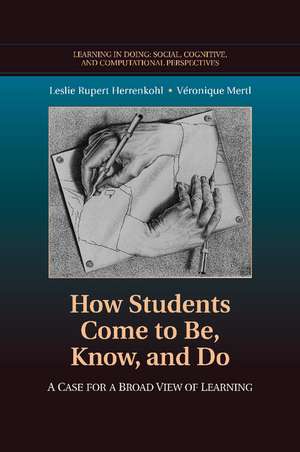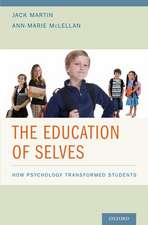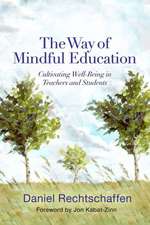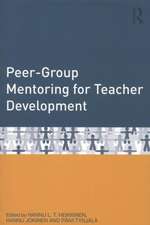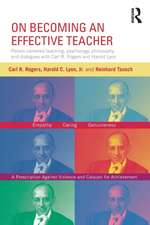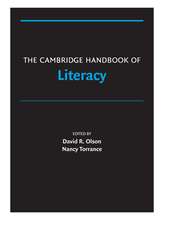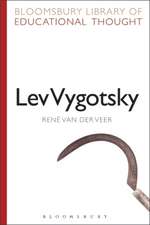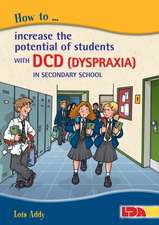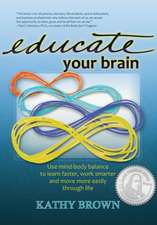How Students Come to Be, Know, and Do: A Case for a Broad View of Learning: Learning in Doing: Social, Cognitive and Computational Perspectives
Autor Leslie Rupert Herrenkohl PhD, Véronique Mertlen Limba Engleză Paperback – 31 dec 2014
| Toate formatele și edițiile | Preț | Express |
|---|---|---|
| Paperback (1) | 282.48 lei 6-8 săpt. | |
| Cambridge University Press – 31 dec 2014 | 282.48 lei 6-8 săpt. | |
| Hardback (1) | 723.09 lei 6-8 săpt. | |
| Cambridge University Press – 29 aug 2010 | 723.09 lei 6-8 săpt. |
Din seria Learning in Doing: Social, Cognitive and Computational Perspectives
-
 Preț: 311.66 lei
Preț: 311.66 lei - 9%
 Preț: 695.96 lei
Preț: 695.96 lei -
 Preț: 319.43 lei
Preț: 319.43 lei -
 Preț: 228.66 lei
Preț: 228.66 lei -
 Preț: 201.39 lei
Preț: 201.39 lei - 11%
 Preț: 493.04 lei
Preț: 493.04 lei -
 Preț: 281.88 lei
Preț: 281.88 lei -
 Preț: 431.40 lei
Preț: 431.40 lei - 14%
 Preț: 900.82 lei
Preț: 900.82 lei -
 Preț: 326.53 lei
Preț: 326.53 lei -
 Preț: 346.50 lei
Preț: 346.50 lei -
 Preț: 296.65 lei
Preț: 296.65 lei -
 Preț: 292.45 lei
Preț: 292.45 lei - 20%
 Preț: 279.91 lei
Preț: 279.91 lei - 11%
 Preț: 459.10 lei
Preț: 459.10 lei -
 Preț: 357.13 lei
Preț: 357.13 lei - 11%
 Preț: 526.58 lei
Preț: 526.58 lei - 14%
 Preț: 784.65 lei
Preț: 784.65 lei -
 Preț: 320.66 lei
Preț: 320.66 lei - 11%
 Preț: 512.98 lei
Preț: 512.98 lei -
 Preț: 332.97 lei
Preț: 332.97 lei - 11%
 Preț: 690.80 lei
Preț: 690.80 lei - 11%
 Preț: 444.70 lei
Preț: 444.70 lei -
 Preț: 324.15 lei
Preț: 324.15 lei -
 Preț: 350.97 lei
Preț: 350.97 lei -
 Preț: 392.00 lei
Preț: 392.00 lei - 20%
 Preț: 516.51 lei
Preț: 516.51 lei -
 Preț: 330.33 lei
Preț: 330.33 lei - 14%
 Preț: 786.15 lei
Preț: 786.15 lei - 5%
 Preț: 321.87 lei
Preț: 321.87 lei -
 Preț: 350.21 lei
Preț: 350.21 lei -
 Preț: 321.27 lei
Preț: 321.27 lei - 14%
 Preț: 726.60 lei
Preț: 726.60 lei -
 Preț: 339.96 lei
Preț: 339.96 lei
Preț: 282.48 lei
Nou
Puncte Express: 424
Preț estimativ în valută:
54.05€ • 56.58$ • 44.99£
54.05€ • 56.58$ • 44.99£
Carte tipărită la comandă
Livrare economică 31 martie-14 aprilie
Preluare comenzi: 021 569.72.76
Specificații
ISBN-13: 9781107479180
ISBN-10: 1107479185
Pagini: 240
Ilustrații: 10 b/w illus. 2 tables
Dimensiuni: 153 x 230 x 14 mm
Greutate: 0.33 kg
Editura: Cambridge University Press
Colecția Cambridge University Press
Seria Learning in Doing: Social, Cognitive and Computational Perspectives
Locul publicării:New York, United States
ISBN-10: 1107479185
Pagini: 240
Ilustrații: 10 b/w illus. 2 tables
Dimensiuni: 153 x 230 x 14 mm
Greutate: 0.33 kg
Editura: Cambridge University Press
Colecția Cambridge University Press
Seria Learning in Doing: Social, Cognitive and Computational Perspectives
Locul publicării:New York, United States
Cuprins
Introduction; 1. The context lens; 2. How ways of knowing, doing, and being emerged in the classroom: interpersonal interactions and the creation of community, part I; 3. How ways of knowing, doing, and being emerged in the classroom: interpersonal interactions and the creation of community, part II; 4. Personal lens of analysis: individual learning trajectories; Conclusion.
Recenzii
“This excellent book beautifully captures the ways in which learning is simultaneously deeply subjective as well as relational. It is an essential resource for science educators who understand learning as entailing more than conceptual or procedural knowledge. Perhaps most importantly, it reveals and carefully documents the ways in which science learning, long described as knowing and doing by advocates of inquiry-based science instruction, is just as inextricably bound with ways of being, that is, with interests, ideas, perspectives, traditions, and life purposes.”
– Bronwyn Bevan, Exploratorium
“Drawing on a rich qualitative data set and utilizing an analytical lens that considers multiple layers of context, including school and classroom systems, teacher-student and peer interactions, and personal negotiations in the classroom, Herrenkohl and Mertl re-envision and reconceptualize the nature of learning. No longer can we think of classroom learning as simply what happens in the heads of students as they sit in their desks. No longer can we ignore the motivational, volitional, and interpersonal aspects of learning. The expanded view of learning offered in this book honors the complexity of human learning and provides a theoretically and methodologically sound approach to understanding that complexity.”
– Na'ilah Suad Nasir, University of California, Berkeley
“This book offers a fascinating account of how one teacher and her 4th-grade students create a classroom consisting of a community of learners. In this rich and detailed study the authors show how both teacher and students are transformed as they engage in a diversity of authentic scientific practices. Their research offers the field detailed insights into how this outcome is achieved, the challenges it presents, and their resolution.”
– Jonathan Osborne, Stanford University
“How Students Come to Be, Know, and Do expands the field’s vision of learning from one of teaching students to developing people. Herrenkohl and Mertl view learning as a dynamic, co-constitutive interaction of conceptual and epistemological practices – in this case, in school science. They present an engrossing case study of fourth grade students from varied backgrounds taught by a remarkable teacher, where the deep and careful intellectual work they do together will ring true for anyone who has spent time in classrooms in which knowledge and ways of knowing are being actively constructed, pulled apart, and reconstructed. One gets a palpable sense of who these students are – as learners of science and doers of life.”
– Ann S. Rosebery, Chèche Konnen Center, TERC
"Herrenkohl and Mertl (both, Univ. of Washiogton) have written a book advocating a broader view of learning than contemporary schools reflect. For those who believe that educational accountability and its attendant focus on semantic learning have created a too focused kind of educational experience, How Students Come to Be, Know, and Do suggests an alternative model.... Herrenkohl and Mertl have a very detailed study of how students learn and how they learn differently. The conclusions are intended to address the problems of students who consistently underachieve.... Recommended...."
- D. E. Tanner, California State University, CHOICE
– Bronwyn Bevan, Exploratorium
“Drawing on a rich qualitative data set and utilizing an analytical lens that considers multiple layers of context, including school and classroom systems, teacher-student and peer interactions, and personal negotiations in the classroom, Herrenkohl and Mertl re-envision and reconceptualize the nature of learning. No longer can we think of classroom learning as simply what happens in the heads of students as they sit in their desks. No longer can we ignore the motivational, volitional, and interpersonal aspects of learning. The expanded view of learning offered in this book honors the complexity of human learning and provides a theoretically and methodologically sound approach to understanding that complexity.”
– Na'ilah Suad Nasir, University of California, Berkeley
“This book offers a fascinating account of how one teacher and her 4th-grade students create a classroom consisting of a community of learners. In this rich and detailed study the authors show how both teacher and students are transformed as they engage in a diversity of authentic scientific practices. Their research offers the field detailed insights into how this outcome is achieved, the challenges it presents, and their resolution.”
– Jonathan Osborne, Stanford University
“How Students Come to Be, Know, and Do expands the field’s vision of learning from one of teaching students to developing people. Herrenkohl and Mertl view learning as a dynamic, co-constitutive interaction of conceptual and epistemological practices – in this case, in school science. They present an engrossing case study of fourth grade students from varied backgrounds taught by a remarkable teacher, where the deep and careful intellectual work they do together will ring true for anyone who has spent time in classrooms in which knowledge and ways of knowing are being actively constructed, pulled apart, and reconstructed. One gets a palpable sense of who these students are – as learners of science and doers of life.”
– Ann S. Rosebery, Chèche Konnen Center, TERC
"Herrenkohl and Mertl (both, Univ. of Washiogton) have written a book advocating a broader view of learning than contemporary schools reflect. For those who believe that educational accountability and its attendant focus on semantic learning have created a too focused kind of educational experience, How Students Come to Be, Know, and Do suggests an alternative model.... Herrenkohl and Mertl have a very detailed study of how students learn and how they learn differently. The conclusions are intended to address the problems of students who consistently underachieve.... Recommended...."
- D. E. Tanner, California State University, CHOICE
Notă biografică
Descriere
This book builds a theoretical argument for and a methodological approach to studying learning in a holistic way.
